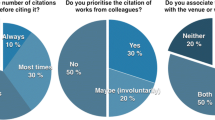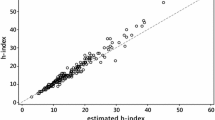Abstract
New indicators, including the outgrow index, characterizing an article in its ego citation network are introduced. We take full advantage of the existing duality (cites–is cited by) in a citation network. Although algebraic aspects are emphasized, a first step towards their interpretation is attempted. Examples of their calculation and of future applications are provided.





Similar content being viewed by others
References
Althouse, B. M., West, J. D., Bergstrom, T., & Bergstrom, C. T. (2009). Differences in impact factor across fields and over time. Journal of the American Society for Information Science and Technology, 60(1), 27–34.
Boyack, K. W., Klavans, R., & Borner, K. (2005). Mapping the backbone of science. Scientometrics, 64(3), 351–374.
Chen, Z. F., & Guan, J. C. (2010). The impact of small world on innovation: An empirical study of 16 countries. Journal of Informetrics, 4(1), 97–106.
Egghe, L., & Rousseau, R. (1990). Introduction to informetrics, quantitative methods in library, documentation and information science. Amsterdam: Elsevier.
Garfield, E. (1963). Science Citation Index: An international interdisciplinary index to the literature of science. Philadelphia: Institute for Scientific Information.
Garfield, E. (1964). Science Citation Index: New dimension in indexing. Science, 144(361), 649–654.
Garner, R. (1967). A computer oriented, graph theoretic analysis of citation index structures. In B. Flood (Ed.), Three Drexel information science research studies (pp. 3–46). Philadelphia: Drexel Press.
Hu, X. J., Rousseau, R., & Chen, J. (2011a). On the definition of forward and backward citation generations. Journal of Informetrics, 5(1), 27–36.
Hu, X. J., Rousseau, R., & Chen, J. (2011b). Time series of outgrow indices. Journal of Informetrics, 5(3), 413–421.
Kessler, M. M. (1963). Bibliographic coupling between scientific papers. American Documentation, 14(1), 10–25.
Leydesdorff, L., & Bornmann, L. (2011). Integrated Impact Indicators compared with impact factors: An alternative research design with policy implications. Journal of the American Society for Information Science and Technology, 62(11), 2133–2146.
Liu, Y. X., & Rousseau, R. (2010). Knowledge diffusion through publications and citations: A case study using ESI-fields as unit of diffusion. Journal of the American Society for Information Science and Technology, 61(2), 340–351.
Marshakova, I. V. (1973). System of document connections based on references. Nauchno-Tekhnicheskaya Informatsiya series, 2(6), 3–8. (in Russian).
Nijssen, D., Rousseau, R., & Van Hecke, P. (1998). The Lorenz curve: A graphical representation of evenness. Coenoses, 13(1), 33–38.
Otte, E., & Rousseau, R. (2002). Social network analysis: A powerful strategy, also for the information sciences. Journal of Information Science, 28(6), 441–453.
Persson, O., Glänzel, W., & Danell, R. (2004). Inflationary bibliometric values: The role of scientific collaboration and the need for relative indicators in evaluative studies. Scientometrics, 60(3), 421–432.
Rafols, I., & Meyer, M. (2010). Diversity and network coherence as indicators of interdisciplinarity: Case studies in bionanoscience. Scientometrics, 82(2), 263–287.
Rousseau, R. (2010). Bibliographic coupling and co-citation as dual notions. In B. Larsen (Ed.), The Janus faced scholar. A Festschrift in honour of Peter Ingwersen (pp. 173–183). ISSI e-zine (special volume).
Rousseau, R (2011). Algebraic structures in the ego article citation network. In E. Noyons, P. Ngulube, J. Leta (Eds.), Proceedings of ISSI 2011—The 13th International Conference on Scientometrics and Informetrics, Durban, South Africa, 4–7 July 2011 (pp. 737–741).
Rousseau, R., & Hu, X. J. (2010). An outgrow index. Annals of Library and Information Studies, 57(3), 287–290.
Singh, J. (2005). Collaborative networks as determinants of knowledge diffusion patterns. Management Science, 51(5), 756–770.
Small, H. (1973). Co-citation in the scientific literature: A new measure of the relationship between two documents. Journal of the American Society for Information Science, 24(4), 265–269.
Wagner, C. S., & Leydesdorff, L. (2005). Network structure, self-organization, and the growth of international collaboration in science. Research Policy, 34(10), 1608–1618.
Wang, J. C., Chiang, C. H., & Lin, S. W. (2010). Network structure of innovation: Can brokerage or closure predict patent quality? Scientometrics, 84(3), 735–748.
Wasserman, S., & Faust, K. (1994). Social network analysis. Cambridge: Cambridge University Press.
White, H. D. (2000). Toward ego-centered citation analysis. In B. Cronin & H. B. Atkins (Eds.), The Web of knowledge. A Festschrift in honor of Eugene Garfield (pp. 475–496). Medford (NJ): Information Today.
Yang, E. J., & Ding, Y. (2009). Applying centrality measures to impact analysis: A coauthorship network analysis. Journal of the American Society for Information Science and Technology, 60(10), 2107–2118.
Acknowledgments
The authors thank Raf Guns (Antwerp University) for stimulating discussions related to the outgrow index and its possible applications. This research is supported by National Natural Science Foundation of China (NSFC Grant No. 71173185); Ronald Rousseau’s research is also supported by the National Natural Science Foundation of China grants (NSFC 7101017006 and 71173154). This article is an extended version of a paper presented at the 13th International Conference on Scientometrics and Informetrics, Durban (South Africa), 4–7 July 2011 (Rousseau 2011).
Author information
Authors and Affiliations
Corresponding author
Rights and permissions
About this article
Cite this article
Hu, X., Rousseau, R. & Chen, J. Structural indicators in citation networks. Scientometrics 91, 451–460 (2012). https://doi.org/10.1007/s11192-011-0587-3
Received:
Published:
Issue Date:
DOI: https://doi.org/10.1007/s11192-011-0587-3




